[Top] [Prev] [Next] [Bottom]
Chapter 8. Fermentation of the Mash
In the previous sections we have seen that the sugar formed by the action of the koji upon the starch of the rice grain undergoes fermentation, that is, is converted into alcohol, carbonic acid, and some other products in smaller quantity. It is now generally admitted that the production of these bodies is the result of the growth of some form of organism, which, in the majority of cases, is a species of the genus Saccharomyces. In beer brewing the yeast ferment is added to the wort after cooling, and then finding the necessary food present it goes on growing and budding rapidly, producing, in addition to the substance of the newly formed cells, alcohol and carbonic acid as the results of its growth. These cells when examined under the microscope have the appearance (shown in Figure 9) of small spherical or oval cells, having a longer diameter of about one-hundredth of a millimeter and frequently with small bubbles in the interior. They grow by a process of budding, that is, a small protuberance forms at the side of a full grown cell, it breaks away, and then acts on its own account. In the fermentation of beer the most important species of alcoholic ferment is the one just alluded to, Saccharomyces cerevisaie.
In the manufacture of wine no ferment is directly added to the must, but it has been found that germs of the alcoholic ferments which subsequently grow and produce the wine adhere to the outside of the skin and stalks of the grape and in that way enter the liquid when the grapes are crushed. The common ferment of wine is Saccharomyces ellipsoideus, but other species are also found, such as S. pastorianus, S. exiguus, S. Conglomeratus, and Carpozyma apiculatum. The following are the average dimensions of these species:
Figure 9: Cells of saccharomyces cerivisae. Skurada beer brewery. Tokyo. x 100.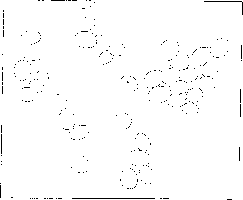
Figure 10: Cells of sake ferment formed in a koji mash after nine days x 748.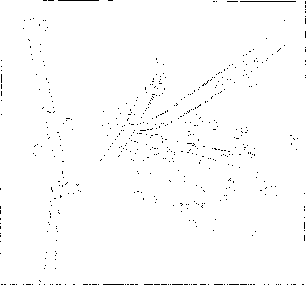
The ferment of beer, therefore, is much larger than any of these species, and although the full grown specimens vary a little in size, they never fall below 0.008 mm in diameter. M. Pasteur has, however, shown that under certain conditions S. Pastorianus may assume very different forms and sizes.
Besides these special alcoholic ferments there are other forms of fungi which are capable of yielding alcohol when they are caused to grown submerged in a saccharine solution. Such are especially the Mucor mucedo and the Mucor racemosus which have been examined by Fitz. They however, never yield a liquid containing more than from 2 to 4 percent alcohol.
Before considering the nature and origin of the ferment which is found in sake breweries, it will be convenient to describe the microscopic appearances presented by the mash at the periods at which the chemical analyses described in the last section were made.
On the first and second days after mixing no appearances of any special interest were to be observed, but on the third day, together with fragments of broken mycelium filled with granulations, isolated cells of ferment were to be seen as represented in Figure 11; the largest of these were only 0.0075 millimeter in diameter. The temperature of the mash at that time 13°C, but it contained no appreciable amount of alcohol. The existence of these cells, however, at this very early stage is of considerable interest, and that they were capable of developing rapidly when placed under the proper conditions is shown by the appearance of a sample which was placed near a stove and left till the following day; represented in Figure 12. In this case large numbers of ferment cells are to be seen, of two kinds, one nearly spherical the largest measuring 0.0081 mm in diameter, and the other longer and almost cylindrical. The appearance was that of an actively growing yeast.
Figure 11: Mash of third day x 740.
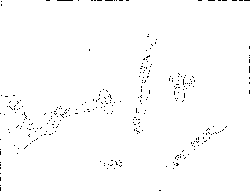
Figure 12: Mash of third day after standing 3 days. x 740.
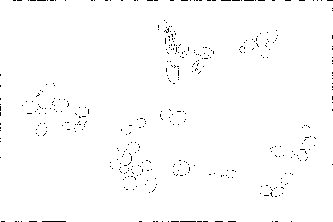
The mash which was left under the usual conditions did not alter thus in appearance. A few more cells may be observed associated with fragments of mycelium, and with others apparently bursting and scattering a fine dust, but there was no active growth, nor did analysis indicate the formation of any alcohol. The appearance of the mash on the fifth day is shown in Figure 13.
Figure 13: Mash of the fifth day, x740.
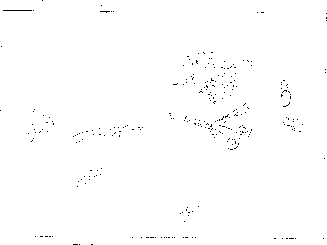
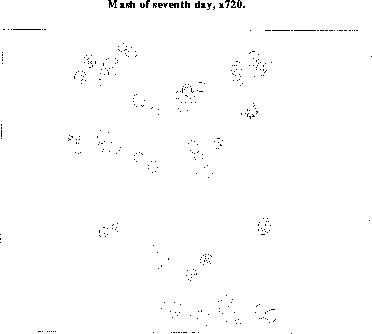
After the last sample was taken the moto was heated, and almost immediately a great development of the ferment cells took place. On the seventh day the temperature was 23°C and the microscopic appearance (Figure 14) shows that the cells were budding and growing with considerable activity, and chemical analysis at the same time indicated the existence of 5.2% alcohol. The diameter of the largest cell was 0.0083 millimeter and the average size 0.0076 mm. The mash on the tenth day had a very similar appearance to that on the seventh, and on the twelfth, although the temperature was then only 10°C, the cells still appeared fresh and vigorous as in the left of Figure 16. At the same time fragments of the mycelium were to be seen as well as a number of very minute cells, the functions of which are not known. On the fourteenth day the cells had much the same character as before, the largest still measuring about the same, i.e., 0.0082 mm.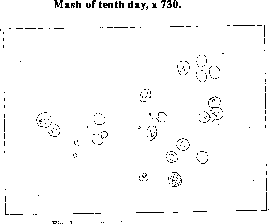
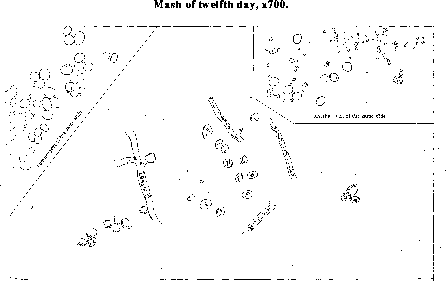
The next sample examined was that taken on the seventeenth day, after the further addition of rice and koji, and when the temperature had risen to 19°C, sufficiently high to promote the very active growth of the yeast. Figure 17 shows the appearance of the ferment on that day, and it will be noticed that the size of the cells is rather less, the largest being only 0.0075 mm, perhaps because they were not fully grown. By the nineteenth day they were again in active growth, and the largest again had a long diameter of 0.0082 mm. The temperature at that time was 25°C and the amount of alcohol increased from 5.8% on the seventeenth day to 9.44% on the nineteenth. The growth of the yeast continued, the temperature of the mash on the twenty-first day being 26°C, but there are to be observed in the figure of this mash other ferment cells, small straight or curved filaments which are the cause of the future deterioration of the sake. They resemble very closely the filaments which are found in "turned" beer and wine, and are also to be found in enormous numbers in sake which has become spoilt. (See Figure 25 and Figure 26).
Figure 17: Mash of fourteenth day, x730.
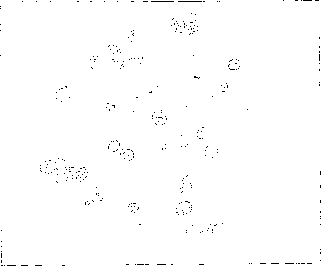
Figure 18: Mash of seventeenth day, x730.
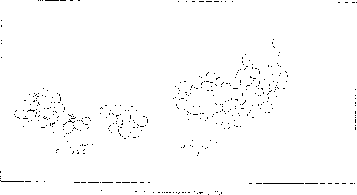
I have drawn also a filament of mycelium to show that it was still present, although as the ferment cells were very numerous and collected at the surface of the mash, the filaments appeared to be not so numerous as at first. The same remark applies to Figure 21 which represents the appearance of the mash on the twenty-fourth day, the last sample of the series which was examined. By this time the temperature had fallen to 20°C, but the fermentation still went on as the increase in the percentage of alcohol proved.
Figure 19: Mash of nineteenth day, x730.
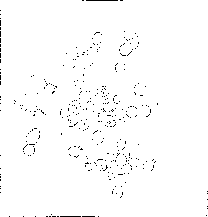
Figure 20: Mash of twenty-first day, x730.
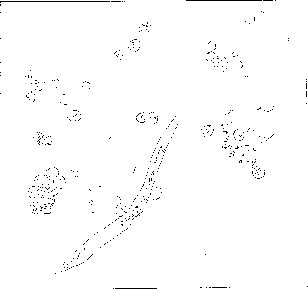
Figure 21: Mash of twenty-fourth day, x730.
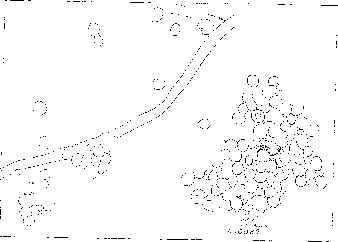
We have here a process of fermentation which resembles the wine fermentation in the fact that no ferment has been knowingly added by the brewer, and which belongs to the class called "spontaneous fermentations." By that term of course it is not meant that the living organisms have been generated spontaneously, without any forefathers, but only that they have appeared without intentional sowing. As the theory that living organisms are produced without the intervention of previous life has no basis of reality we are driven to enquire from what source these small particles of ferment have been derived. This has been discussed by Mr. Korschelt1 in a paper read before the German Asiatic Society, and he very rightly says that we may conceive of their introduction in three different ways. In the first place he says that the grains of koji may carry upon their surface germs of the yeast in the same way that the grapes carry into the fermentation vat the cells which afterwards effect the conversion of sugar into alcohol. Or the germs of the yeast may in the second place fall into the vats from the atmosphere. To both explanations he considers that the sudden commencement of the fermentation is sufficient objection, for, as will be remembered, between the time of heating of the vat, and the time of taking the first sample afterwards, a period of 41 hours, more than 5% of alcohol had been formed. Mr. Korschelt, therefore, inclines to the third possibility, viz., that the mycelium fibers of the koji fungus have been changed into the ferment cells, and he bases this supposition upon the observations made by Du Bary and Rees that the mycelium of the two species of Mucor, M. mucedo and M. racemosus, have the property under certain conditions of forming cells which are able to convert sugar into alcohol.
The question is one of very great scientific interest, and no apology is therefo
re required for entering into a somewhat minute investigation of it. For a long
time it was supposed that such common air fungi as Penicillium glaucum, and Sper
gillus glaucus might, under suitable conditions, be transformed in the ordinary
alcoholic ferment, and in that state go on converting sugar into alcohol. M. Pas
teur2 has put this theory to most rigorous test
s, and has proved in the most conclusive manner the absence of any evidence what
ever of such a transformation. He has shown that if proper care be taken to excl
ude every germ but the one being experimented upon, no conversion of that spore
into any other species takes place. Thus a spore of Penicillium or of Aspergillu
s, or of Mycoderma vini will grow in ordinary wort so long as it has sufficient
air to breathe and is provided with sufficient food, but it is never converted i
nto what is usually termed an alcoholic ferment. At the same time if the air be
excluded he finds that the plant will go on growing for a longer or shorter time
after the exclusion of the oxygen, but that its life is then carried on under a
bnormal conditions, which is evidenced by a change in the form of the mycelial f
ibers, and by the fact that a certain amount of alcohol is produced. The myceliu
m becomes swollen and contorted, and shows a tendency to break up into small cells attached end to end, and it is only in this state that the plant is capable of forming alcohol, but it does this without the presence of a single cell of the common yeast. If the swollen mycelium cells be again allowed to grow under the usual conditions, that is with plenty of food and air, they reproduce the normal form of the plant from which the spores were originally taken. It may in fact be taken that while the fungus is healthy, growing under normal conditions, it consumes sugar, converting it into water and carbonic acid without producing any alcohol whatever, but that as soon as it no longer meets with the requisite quantity of free oxygen, still remaining in presence of sugar, it falls ill, and in that diseased condition it lives for a longer or a shorter time, producing alcohol as a pathological product. All fungi are not so easily killed, some may produce a very large quantity of alcohol before they die, and may even go on reproducing fresh cells. The Mucor mucedo, for instance, according to Fitz is killed when the liquid contains more than 1% alcohol, while the Mucor racemosus is more tenacious of life, and is not killed until the liquid contains from 2 to 4-1/2 %, according to different observers.3 There may be all variations in the case of different fungi, and although no case is at present known of one of the common air fungi yielding a greater percentage of alcohol than that given by the Mucor racemosus, there is no inherent improbability in the supposition that some fungi may yield much more. In fact the chemical difference between what are usually termed ferments and the ordinary fungi, seems to be their power of living out of contact with free oxygen, deriving that which they require from sugar, and thus causing it to split up into various other products in the manner shown by some such equations as the following:
 C12H12O6
C12H12O6 = 2 C2H6O
= 2 C2H6O + 2 CO2
+ 2 CO2
 4 C6H12O6
4 C6H12O6 + 3 H2O = C4H6O4
+ 3 H2O = C4H6O4 + 6 C3H8O3
+ 6 C3H8O3 + 2 CO2 + O (Monoyer)
+ 2 CO2 + O (Monoyer)
Mr. Korschelt's supposition that the mycelium of the koji fungus itself breaks u
p and goes on living as a ferment would be remarkable, therefore, only in the fa
ct that the cells were able to live in a liquid containing as much as 15% alcoho
l, a very much higher percentage than the common beer yeast can exist in. But th
e question naturally arises whether the conditions under which the fermentation
is carried on are such as would permit a fungus which ordinarily grows in air to
live with such results immersed in a liquid. M. Pasteur has shown that in propo
rtion as the fungus is provided with air it grows without producing alcohol, and
, if the conditions are such that the plant can get plenty of free oxygen, no al
cohol will be formed. Even the ordinary brewers yeast at the beginning of the fe
rmentation process grows in a vigorous manner but without producing alcohol, bec
ause it is at that time living upon the free oxygen dissolved in the wort, but b
y that means it acquires a freshness which enables it to grow at a later period
with great vigor at the expense of the sugar contained in the wort. M. Pasteur t
hus explains the custom of aerating the wort followed in distilleries and in works for the manufacture of yeast. Are not the same conditions to be found in the manufacture under discussion? During the first few days the mixture of rice, koji, and water, divided as it is amongst a number of small vessels, exposes a large surface which allows it to become perfectly saturated with air, so that, when the whole quantity of liquid is collected in one large tub and heated the ferment is enabled to grow vigorously, and as soon as the air has been used up, to produce alcohol at the expense of the sugar formed in the previous stage. We can readily understand that these conditions would be suitable for the growth of such a form of ferment as beer yeast, which shows very little tendency to assume the air form (aerobian), but they appear to be less suited to the growth of a mycelium, such as that of the Eurotium. In fact until the mass is collected into the single vat, if the mycelium grows at all, it will form long, thin filaments, which will not produce alcohol, and it will only be when all the oxygen has been exhausted that any alcohol will be produced. Before very long, however, the mash is allowed to cool down by being again spread out in shallow vessels, and during this time, as a large surface is exposed the air, the mash will again become charged with oxygen, and no more alcohol should be formed. What do we actually find? The heating in the large tub lasted in the brewing operation, described earlier, from 3 p.m. on the fifth day until 7 a.m. on the eight day, after which the mixture was transferred to the shallow vessels. Yet even after the tenth day the amount of alcohol increased, not much it is true, because the temperature conditions were unfavorable, but enough to show the fermentative activity of the yeast. If we had to do with an air-fungus, it would not be expected that the formation of alcohol would go on under such conditions, but it is quite what would be expected from the growth of a common yeast.
Again, during the main process, the mash is continually aerated by repeated beating, and we can hardly reconcile this with the production of the large amount of alcohol if the ferment were like the submerged mycelial fibers of a Penicilium or an Aspergillus. Such treatment, however, would be quite compatible with the active growth and fermentative activity of a species of saccharomyces, and would indeed answer to the aeration of the wort practiced by distillers.
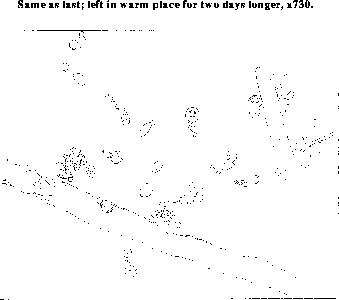
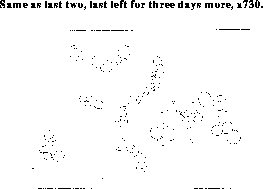
Further, in the drawings illustrating the microscopic appearance of the ferment
during the fermentation, portions of mycelium will be observed at all stages, an
d yet in no case was there observed any thickening such as M. Pasteur has figure
d in figures 20 and 21 (English edition) in the case of Aspergillus glaucus and
Mucor racemosus, and in Plate VI. and figure 24 of Mucor mucedo.4 The mycelium remained of the same form throughout the series
of observations made at the brewery and only changed in appearance from the pres
ence of minute granulations, probably some form of foreign organism which found
a resting place within the fibers. Mr. Korschelt has referred to this appearance
, as well as to the more frequent crossings in the mycelium, as one of the reaso
ns for supposing that the ferment cells observed are actually different forms of
the original mycelium. I have not been able to satisfy myself that the crossing
s of the mycelium are more frequent after the plant has been submerged for some
time than at first, but even if it were so, it does not seem that it would neces
sarily have any bearing upon the question. Nor am I able to agree with Mr. Korsc
helt when he says that there is a marked difference in the abundance of the myce
lium at the beginning and the end. The point upon which most stress is laid is t
he suddenness of the fermentation, and that it does appear suddenly is a matter
about which no one can have any doubt; but is there not a very simple explanatio
n of it apart from the transformation of the mycelium into ferment cells? The fe
rmentation appears immediately after the warming of the mash, which has already
been exposed to the air in shallow vessels for several days before being gathere
d into a single vessel. It is also allowed to remain in the tub for several hour
s before heating, during which time we may suppose that a large part of the diss
olved oxygen has been absorbed by the ferment. By heating the temperature is rai
sed to about 25°C and that we know is very favorable for the growth of yeast. Knowing how rapidly the yeast plant buds under the conditions, it does not appear to be necessary to invoke the transformation of the mycelium into ferment cells in order to account for the sudden appearance of the fermentation, and to my mind the simple and natural explanation is that the fermentation is spontaneous, that the germs are found either on the koji used, or attached to the vessels in which the operations are performed. Mr. Korschelt has referred to the fact that on one occasion, before the fermentation had properly developed itself, I observed some completely cylindrical cells. Unfortunately I did not take sketches of these cells at the time, but it is probably that they were some species of mycoderma, introduced accidentally. I have repeatedly digested koji with water without observing any change in the appearance of the mycelium. The successive changes usually seen are represented with sufficient clearness in Figure 22, Figure 23, and Figure 24. A quantity of koji was placed in a flask with some water, the flask corked and provided with a delivery tube leading into water, and then left near a stove. After two days a drop withdrawn and examined under the microscope appeared as shown in Figure 22, enlarged 730 diameters. Any one comparing this drawing with either figure 10 or figure 11 of M. Pasteur's work "Sur la Biere", which represent alcoholic ferments directly derived from the atmosphere, will see the close resemblance they bear to one another, and will hardly entertain any doubt concerning their atmospheric origin. On allowing this flask to remain for two days longer, there was a slight difference observable, the number of cells of alcoholic ferment had increased, and after three days more fermentation was v
It is, of course, a matter of great difficulty to prove any proposition of this kind, but the probability appears to my mind to be very greatly in favor of the hypothesis that the germs have been either air sown or were adherent to the grains of koji before use.
The average size of the fully grown ferment cell is about 0.0082 millimeter, that is, between that of the ordinary wine ferment, and that of the beer yeast. From the many different appearances which the Saccharomyces Pastorianus puts on, it is difficult to say whether this ferment cell agrees in species with any of the European ferments, but from the large proportion of alcohol in the liquid in which it can exist, it appears to differ from beer yeast. The ferment of wine may produce a liquid containing as much as 15% alcohol, and from this resemblance as well as from the origin of the fermentation, sake making approaches more nearly the wine than the beer manufacture.
[Top] [Prev] [Next] [Bottom]
1
Mitt. der Deutsch. Gessells. 16tes Heft., p. 258.
2
Etudes sur la Biere, 1876, p. 86, English translation, p. 86 et seq.
3
4-1/2 % (Brefeld), 3.3 to 3.4 % (Pasteur), 2.3 to 2.7% (Fitz).
4
I have grown the "tane" (spores) in boiled malt wort, and though the mycelium produced was kept submerged, no change in its form resulted, nor did cells of alcohol ferment make their appearance.
stevens@stsci.edu













 C12H12O6
C12H12O6 = 2 C2H6O
= 2 C2H6O + 2 CO2
+ 2 CO2 4 C6H12O6
4 C6H12O6 + 3 H2O = C4H6O4
+ 3 H2O = C4H6O4 + 6 C3H8O3
+ 6 C3H8O3 + 2 CO2 + O (Monoyer)
+ 2 CO2 + O (Monoyer)

